Affiliate disclosure: This post may contain affiliate links. Please see our Privacy Policy.
Strawberry jam is a springtime classic, and this easy strawberry jam recipe requires just three ingredients and comes together without added pectin.
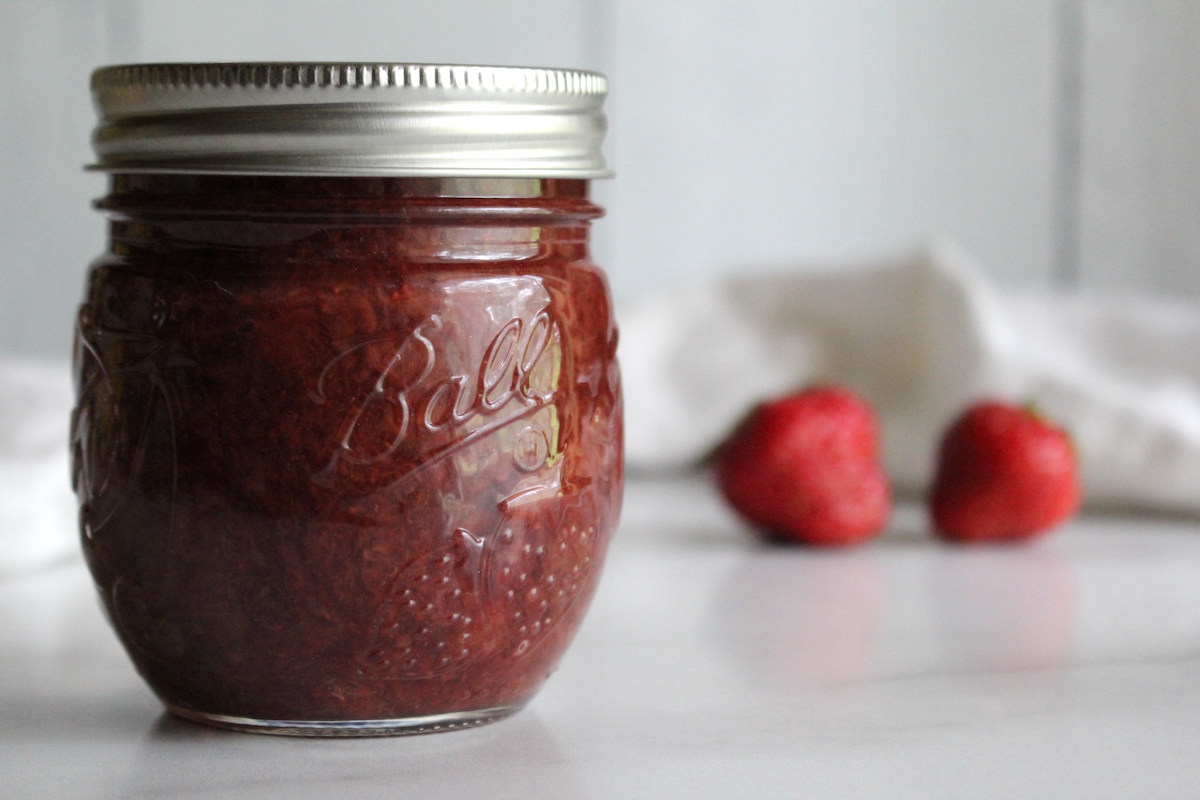
Strawberries are what get my littles to the garden every spring, and they’ll pick their fill before spending the rest of the morning happily playing between the rows. Seeing their smiles meant that I never wanted to have a year without strawberries in the garden, and every year we add a new strawberry bed or two.
Over time we’ve added literally dozens of varieties, from classic June-bearing strawberries to day-neutral everbearing strawberries that fruit all summer long. We’ve got alpine strawberries, and even some exciting new pineberries (white strawberries with a tropical pineapple flavor).
With all these strawberries, we make a lot of homemade strawberry jam!
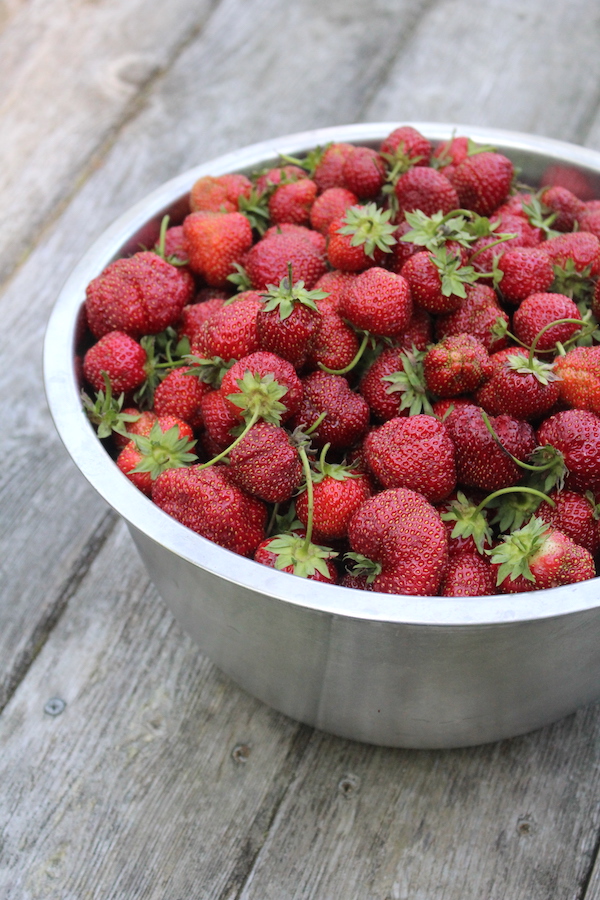
My preference is always simple, old-fashioned recipes without added pectin. I don’t like to use the boxed stuff if I can avoid it.
My main reason is quality and jams made the old-fashioned way usually taste better and have a better finished texture. Put a natural no pectin jam next to a boxed pectin jam and you’ll see what I mean…one is silky smooth and nicely set, the other one is not nearly as nice. In the worst cases, it’s more like gelatin than jam.
Beyond quality, it’s also about cost.
I’m making jam with strawberries from our garden, to fill jars that I bought a decade ago. Sugar is pennies a pound, and new canning lids don’t cost much either. If I can learn to how to make jam without pectin, it’s almost free.
It costs around $6 for a box that will only make 4 half-pint jars, which quadruples my cost per jar.
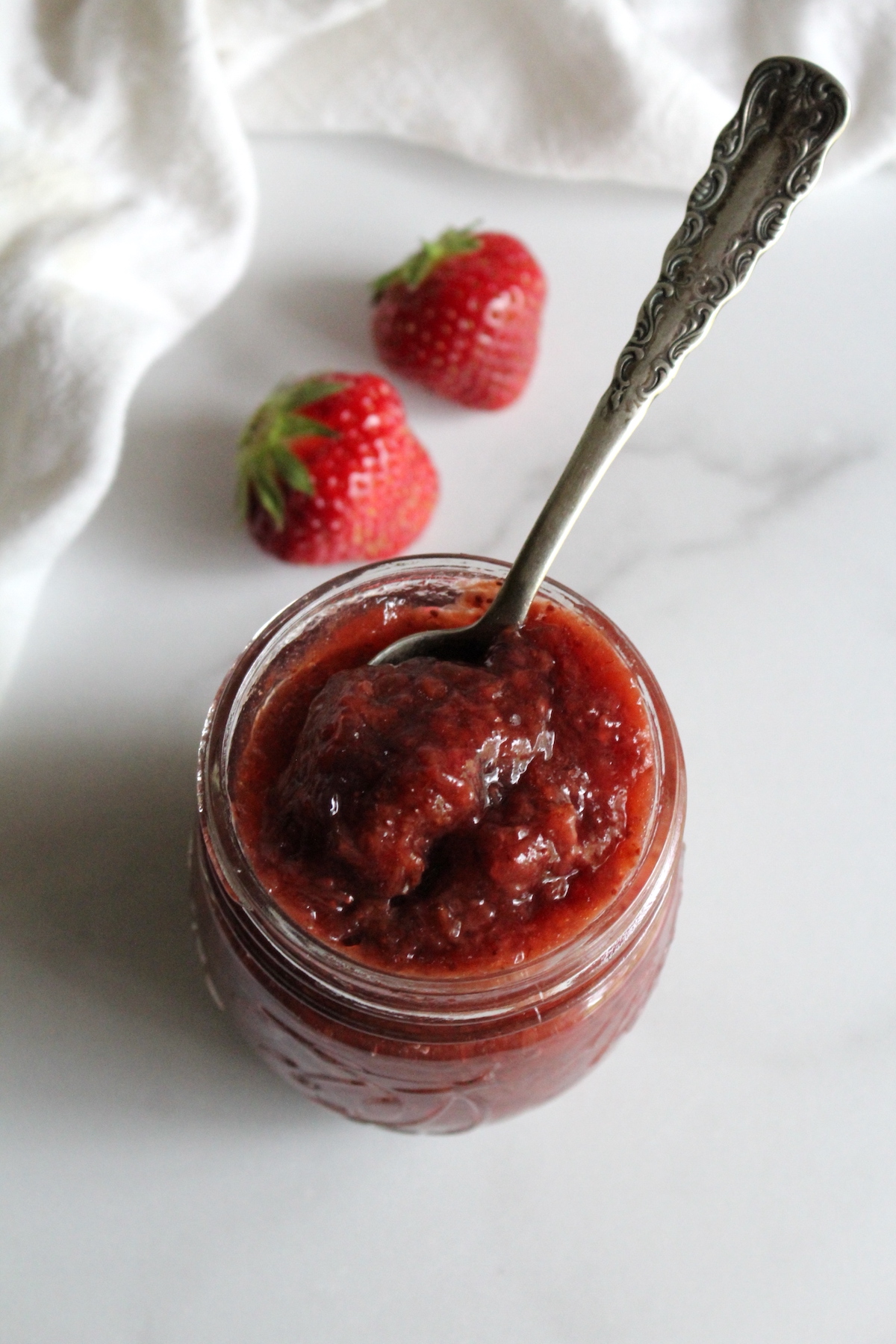
Ingredients for Strawberry Jam
There are plenty of different strawberry jam recipes without pectin, and most of them require strawberries, sugar, and lemon juice. The relative quantities and preparation vary quite a bit between recipes, and some require macerating the fruit or roasting it.
I’m adapting a simple strawberry jam recipe from the book So Easy To Preserve, which is one of the best reference books on canning and food preservation available anywhere. It’s put out by the University of Georgia Cooperative Extension, and much of the National Center for Food Preservation’s canning research and advice comes directly from them.
I’m adapting their recipe slightly by adding lemon juice which helps the jam set and adds a lovely flavor. It also balances the sweetness from the sugar. (The original recipe just uses strawberries and sugar.)
You’ll need the following:
- 8 cups mashed strawberries (from about 4 quarts of fresh fruit, 2 kg, or about 4 1/2 to 5 lbs)
- 6 cups sugar
- 2 tbsp lemon juice (fresh or bottled)
In this recipe, feel free to use fresh lemon juice if you have access to good lemons. Most canning recipes specify bottled lemon juice, and that’s because it’s at a standardized acidity and it’s carefully measured to make the recipes safe for canning.
In this case, strawberries are acidic enough on their own for safe canning, so we’re using lemon juice for flavor and pectin. Use the fresh stuff, or bottled, your choice.
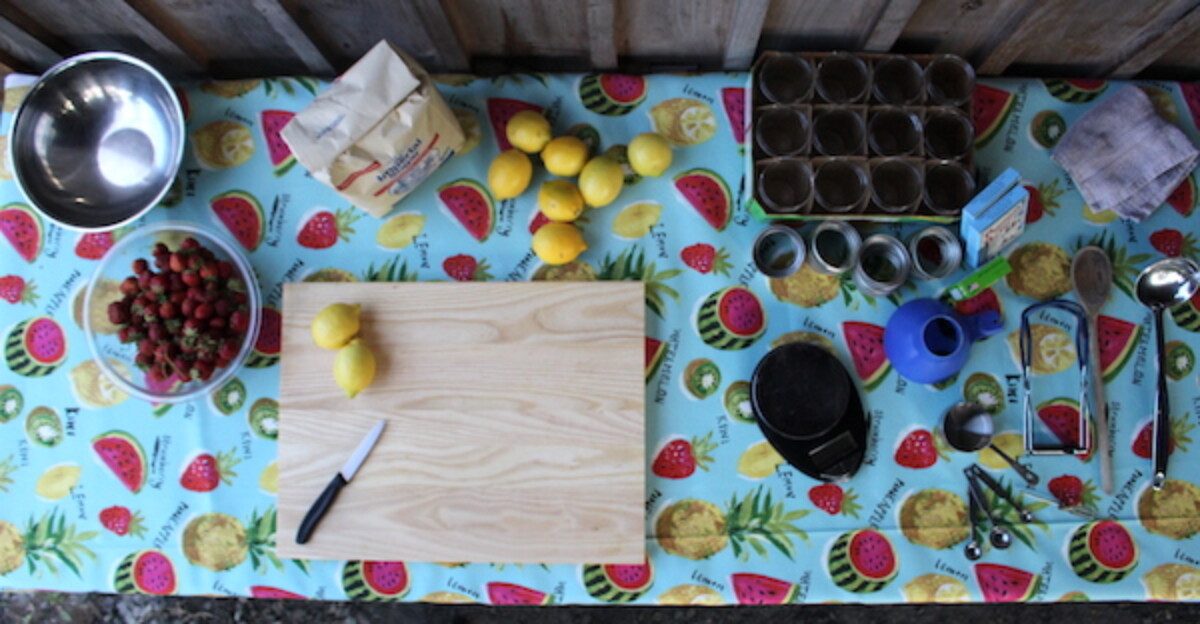
Some European strawberry jam recipes opt for equal parts fruit and sugar, which would mean 8 cups mashed fruit to 8 cups sugar. This recipe uses a bit less, and opts for a 3:4 sugar to fruit ratio, which lets you enjoy the fresh taste of the fruit a bit more.
This is the minimum amount of sugar you can use and still get the jam to set reasonably. I’ve tried, and even using slightly less sugar (4 or 5 cups) doubles the cooking time and results in a jam that tastes like fruit leather in a jar. It just cooks forever and there’s no fresh strawberry flavor left.
If you want to use less sugar, you’ll need to use low sugar pectin to get the jam to set.
I have a recipe for low sugar strawberry jam using Pomona’s pectin which works wonderfully, but it’s completely different than this old-fashioned strawberry jam. The flavor is less concentrated since it’s not cooked down at all. It’s less sweet, but also less flavorful (in my opinion).
I’d suggest trying this recipe as is and adding more lemon juice if you like a tart flavor to your homemade jam. Just double the lemon juice to 4 tbsp for every 8 cups of mashed fruit (or add even more if that suits you).
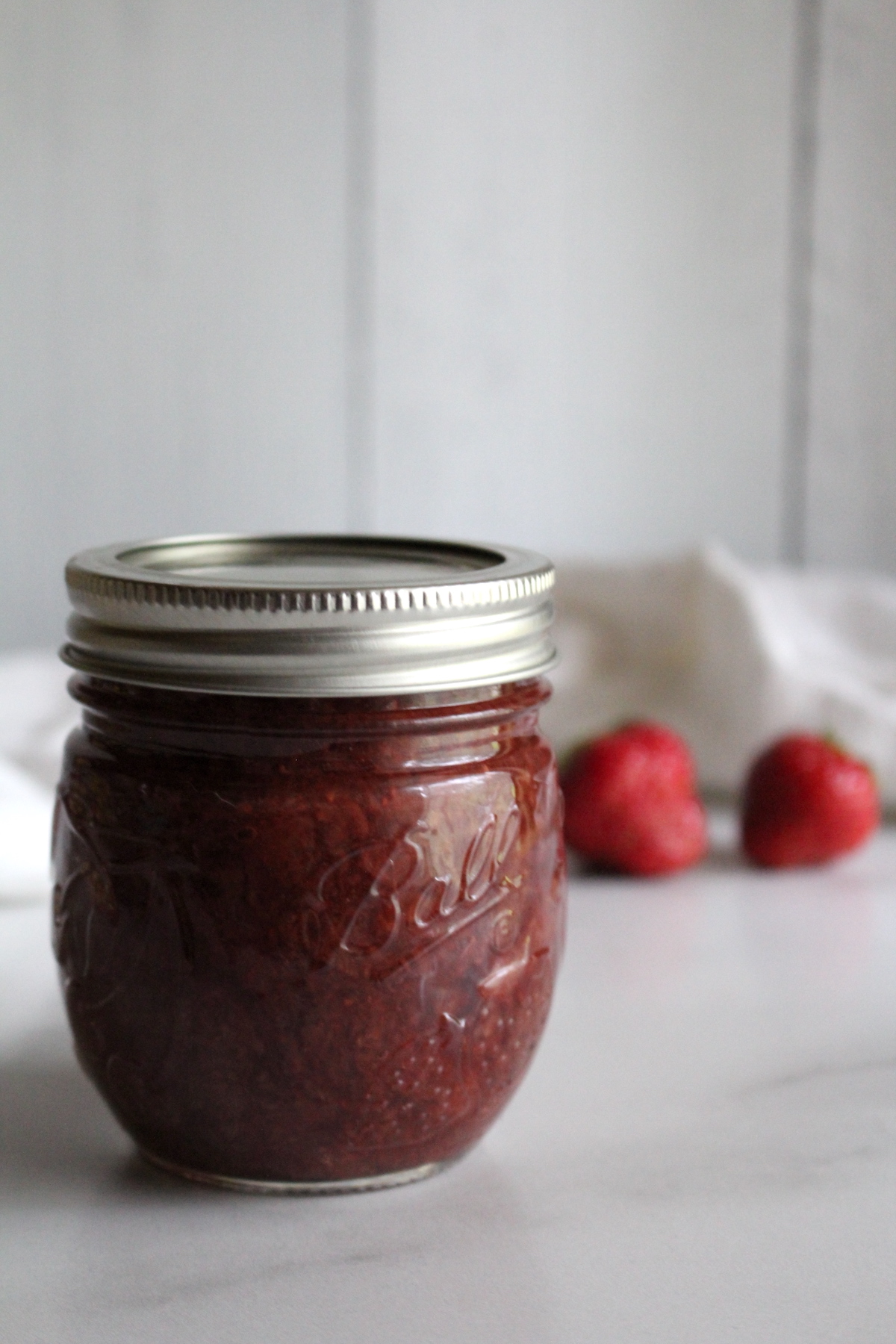
Best Strawberries for Jam
To make strawberry jam, start by choosing the freshest berries possible.
Avoid frozen berries, as freezing fruit for as little as a week can reduce the pectin content by half. Strawberries are already low pectin, so this just won’t work nearly as well with frozen fruit. If frozen fruit is all you have, opt for a recipe that uses pectin.
If you’re harvesting the berries yourself, try to pick ever so slightly underripe fruit, or a portion of underripe fruit. Most old-fashioned jam recipes without pectin suggest using 1/4 to 1/3 slightly underripe fruit, regardless of the variety.
Fruit loses pectin as it ripens, so just a tiny bit underripe will help the whole batch set. (Not too green obviously, as those berries are tough and not sweet.)
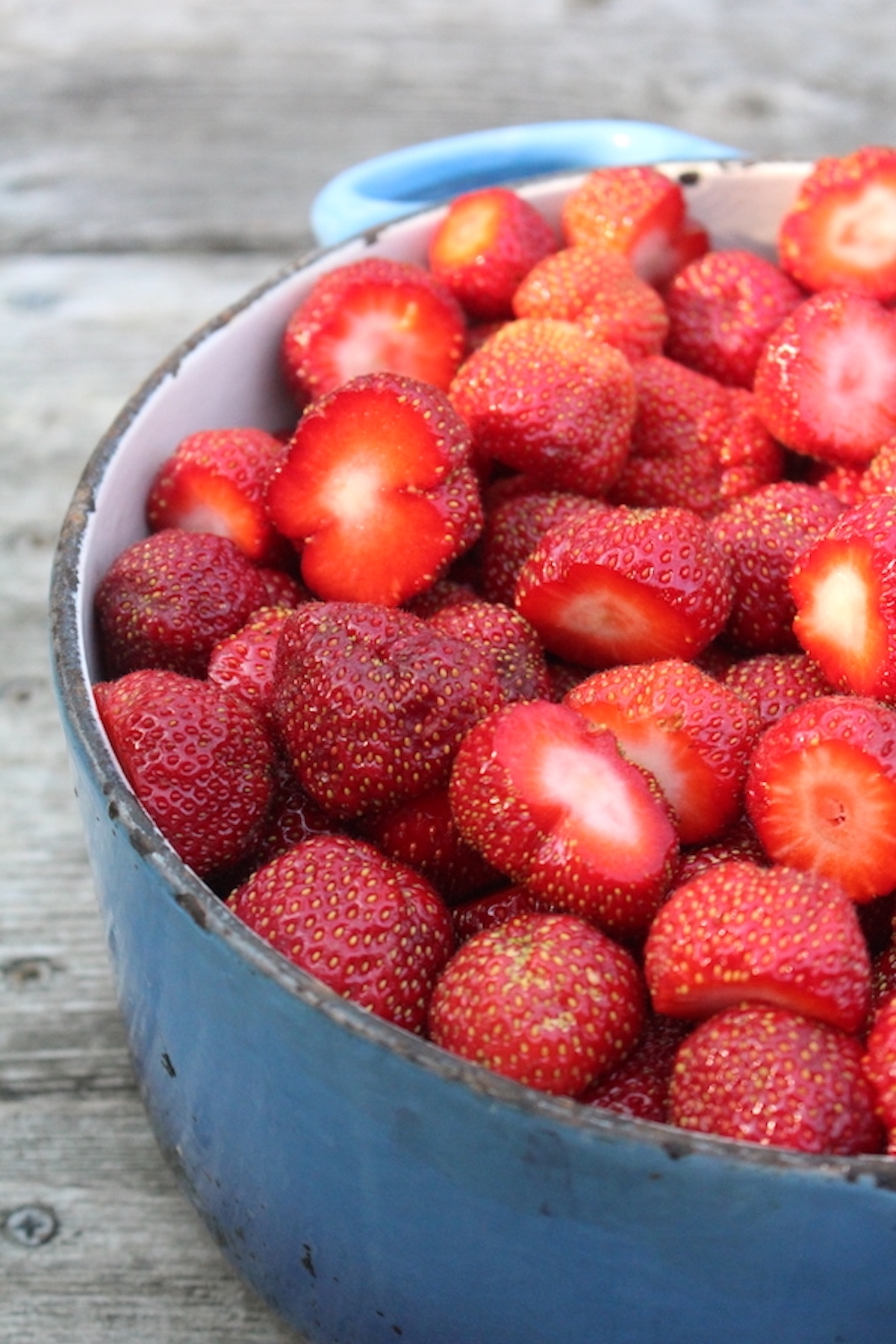
Making Strawberry Jam Without Pectin
Start by washing and picking over the fruit. Remove any spoiled fruit, or hard green fruit, but leave slightly underripe berries.
Hull the fruit to remove the greens and stem ends. Slice and mash the fruit, and then measure the mashed fruit.
You should have 8 cups (or 4 quarts) of mashed fruit. That’s about 4 pounds of prepared mashed strawberries.
Place the mashed fruit in a deep, heavy-bottomed dutch oven or stockpot. Add the sugar and lemon juice, then stir to combine.
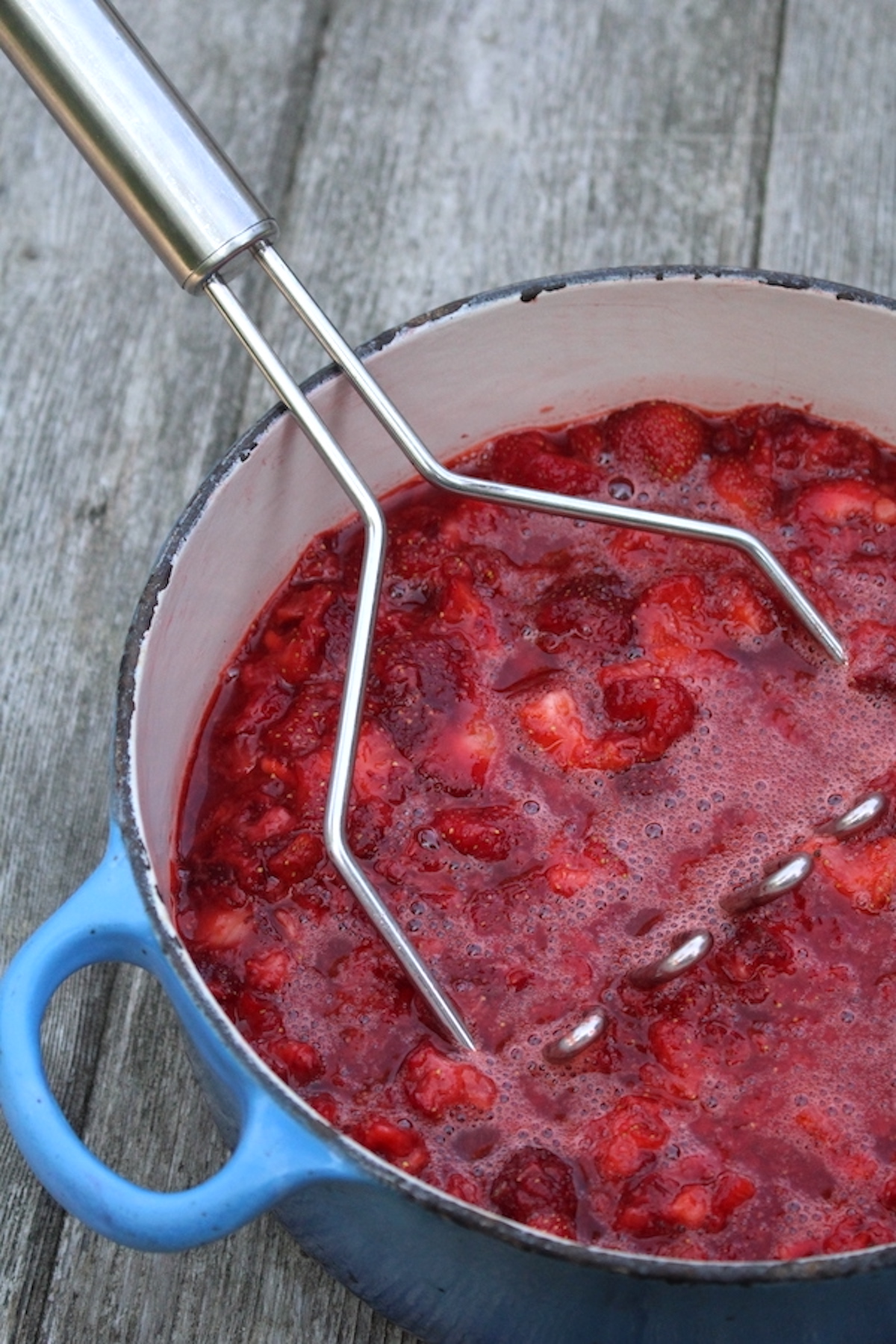
Be sure that the fruit and sugar don’t come too far up the sides of the pan. The pan should be no more than half full, as this jam will foam as it cooks.
Bring the fruit and sugar to a boil over medium-high heat, stirring frequently. Boil gently until the fruit mixture thickens, skimming if necessary. It should take about 45 minutes for this jam to set, but it could be longer depending on the fruit or the exact temperature of your stove.
I’m using a high output 3 burner outdoor stove in my outdoor canning kitchen, so it cooks a bit hot and finishes faster (but I have to be extra careful to watch it to avoid scratching and overflows.)
It’s convenient for canning, as it allows me to use my high capacity Amish Made Canner and I don’t heat up the house with the steam from making jam.
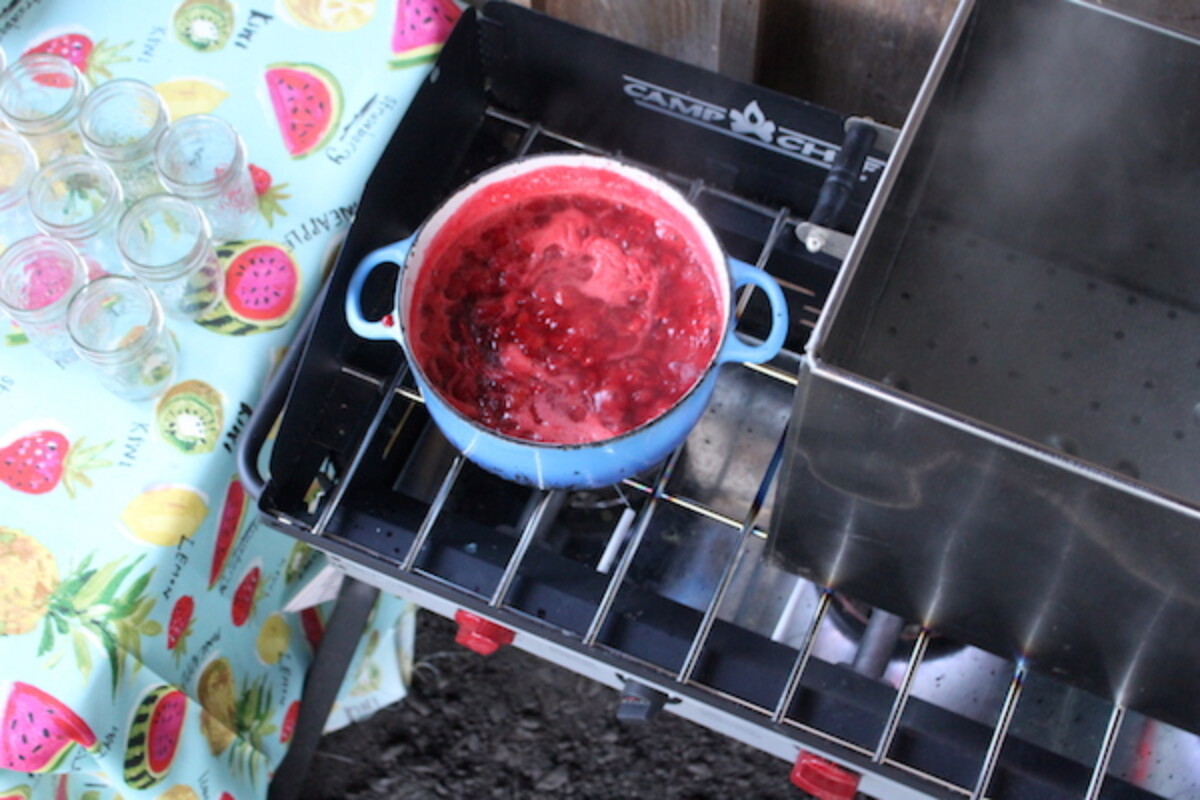
The jam is ready when it sheets off a spoon, or sets when spooned onto a plate that’s been chilled in the freezer.
If you’re looking for a more exact measure, the setpoint of jam is 220 degrees F at sea level, or 8 degrees above the boiling point of water.
At higher elevations, subtract 1 degree for every 500 feet in elevation above sea level. For example, at 1,000 feet in elevation, the jam should finish at 218 F.
Once the jam is set, ladle it into prepared jars leaving 1/4 inch headspace.
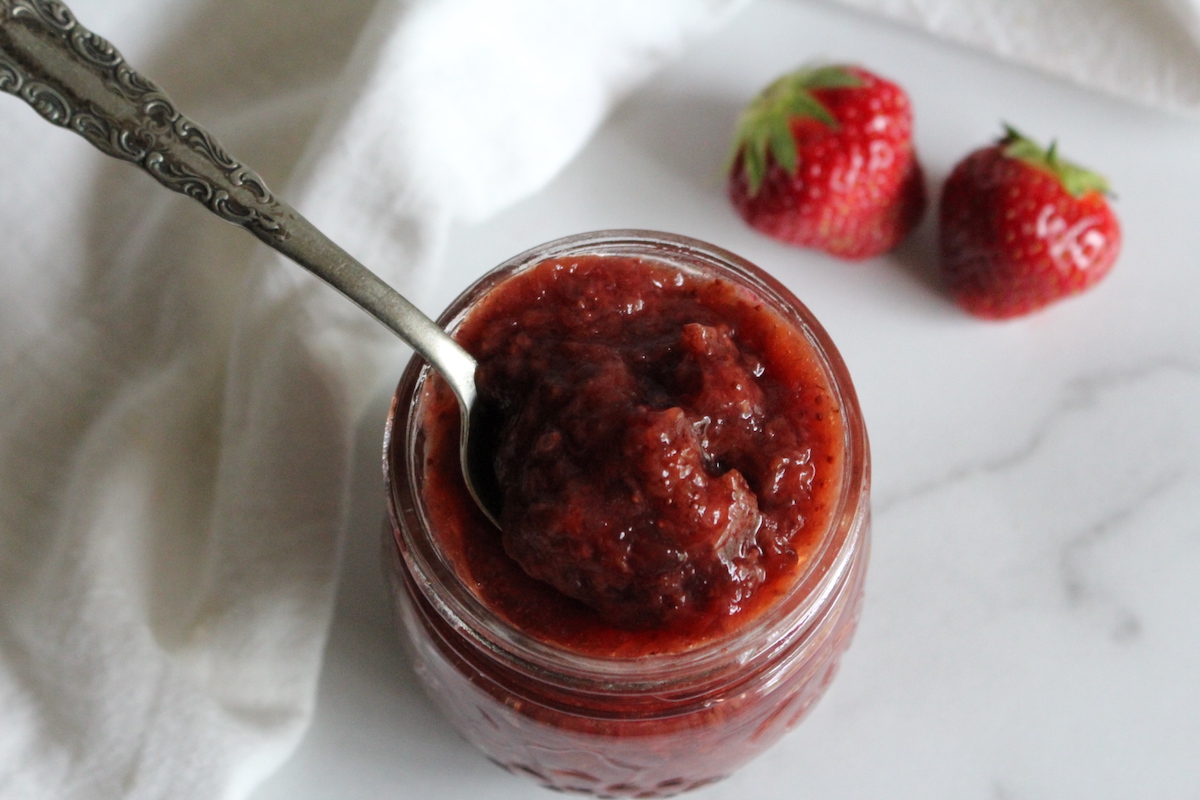
Canning Strawberry Jam
It’s perfectly fine to make this strawberry jam recipe as a refrigerator or freezer recipe. It’ll keep for several weeks in the refrigerator or up to 6 months in the freezer.
Personally, I prefer to can my homemade jams because it saves freezer space and I can enjoy them year-round right from the pantry shelf.
If you’re not familiar with canning, I’d suggest reading this beginner’s guide to water bath canning before getting started, and make sure you have all the right canning supplies on hand as well.
To can strawberry jam, start by preparing a water bath canner, jars, and lids before you start making the jam.
When the strawberry jam reaches its set point, ladle it into prepared canning jars leaving 1/4 inch headspace. Cap with 2 part canning lids to finger tight.
Process the jam in a water bath canner for 10 minutes if below 6,000 feet in elevation. Above 6,000 feet, add 5 minutes for a total of 15 minutes.
Once the canning time is complete, turn off the heat and allow the jars to sit in the water for an additional 5 minutes before using a jar lifter to remove them. (This extra 5 minutes helps prevent thermal shock on the jars when they’re removed, which can result in siphoning.)
Remove the jars and allow them to cool undisturbed for at least 12 hours on a towel on the counter. Once cool, check seals and store any unsealed jars in the refrigerator for immediate use.
Properly canned and sealed jars should maintain peak quality for 12-18 months on the pantry shelf.

Ways to Preserve Strawberries
Looking for more ways to put up a bumper crop of strawberries?
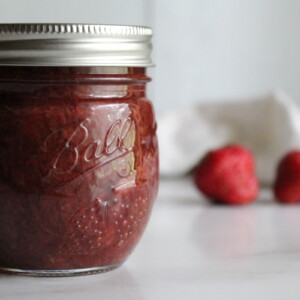
Old-Fashioned Strawberry Jam (Without Pectin)
Ingredients
- 8 cups strawberries, mashed, from about 4 quarts of fresh fruit, 2 kg, or about 4 1/2 to 5 lbs
- 6 cups sugar
- 2 tbsp lemon juice, fresh or bottled
Instructions
- Wash and hull strawberries to remove tops.
- Mash strawberries and measure the fruit. You should have about 8 cups.
- Add strawberries, sugar, and lemon juice to a deep, heavy-bottomed dutch oven or jam pot.
- Bring the mixture to a boil over medium-high heat on the stove, stirring frequently to prevent scorching or overflows.
- Boil gently over medium heat for about 45 minutes to an hour, until the jam reaches its set point. The time will vary based on the water content of your strawberries and the exact heat from your stove.
- Test for set using a plate that’s been chilled in the freezer, or using an instant-read thermometer. The set point of strawberry jam is 220 F at sea level, and drops by 1 degree for every 500 feet above sea level. For example, at 1,000 feet in elevation the jam will set at 218 F.
- When set, ladle into prepared jars leaving 1/4 inch headspace. Seal with 2 part lids to finger tight.
- If canning, process jars in a water bath canner for 10 minutes (or 15 minutes above 6,000 feet in elevation). Turn off the heat and allow the jars to sit for an additional 5 minutes before removing them with a jar lifter to cool on a towel on the counter.
- Check seals after 12-24 hours and store any unsealed jars in the refrigerator for immediate use.
- Properly canned and sealed jars will keep for 12-18 months on the pantry shelf. Refrigerate after opening. If not canning, this jam will keep for several weeks in the refrigerator, or 6 months in the freezer.
Notes
Nutrition
Nutrition information is automatically calculated, so should only be used as an approximation.
Old Fashioned Jams without Pectin
Strawberries aren’t the only fruit you can make into a tasty old-fashioned jam without pectin…
Summer Canning Recipes
Putting up more than jam this season?
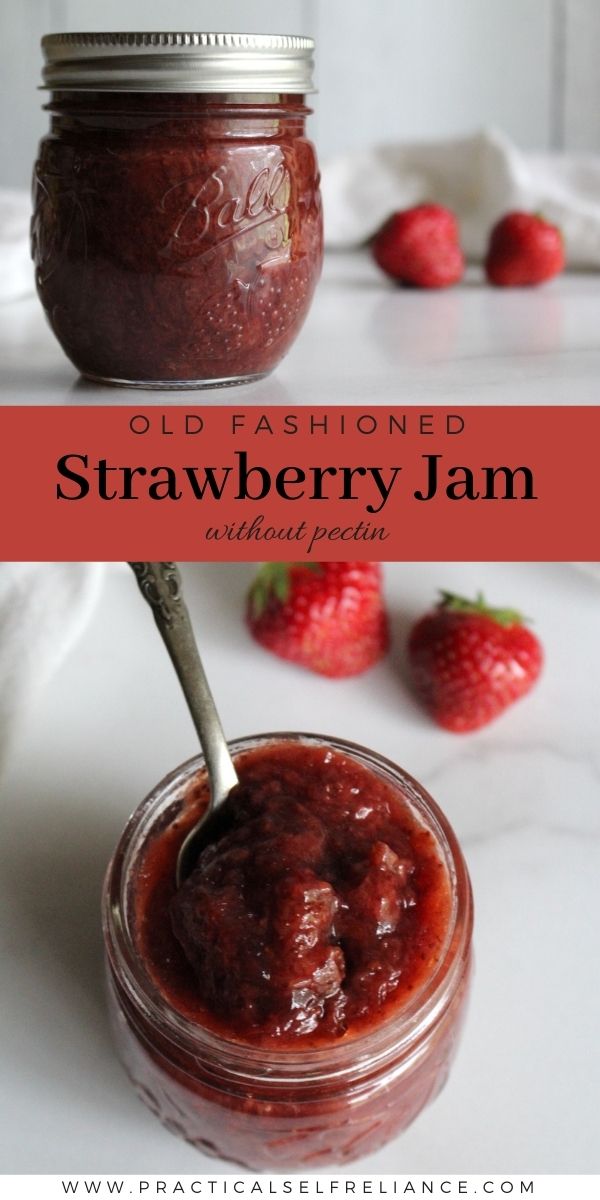



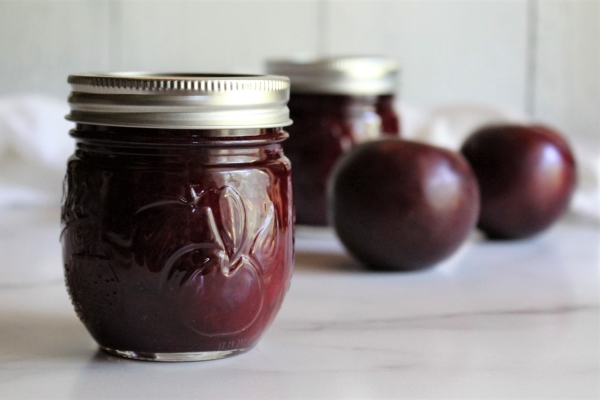










I used strawberries from my garden that were in the freezer about 6 months. I added half more lemon juice and cooked it to 221 degrees and the jam came out perfect! Great recipe thank you!
Wonderful! I’m so glad it turned out nicely for you =)
Very pleased with the results of this jam! Absolutely delicious! Thank you! Looking forward to trying more of your recipes!
Glad you liked it!
I love how easy This recipe is. I am very much a newbie to canning and preserving so easy is good! Because this doesn’t use any pectin, I would say it is a little sweet for my taste especially considering how sweet my garden fresh strawberries already are. I think I will try Your low sugar recipe next! Thank you again Ashley
You’re right, without the pectin it does need quite a bit of sugar to set. Try the low sugar recipe if you’d like to use less, and that one sets nicely with pectin added even with less sugar.